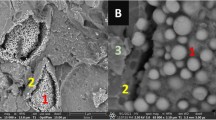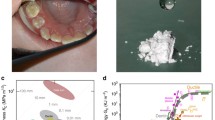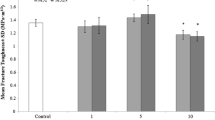Abstract
A linear elastic fracture mechanics approach has been used to characterize failure in glass-ionomer cements. The toughness, fracture toughness, flexural strength and inherent flaw size increase with the molecular weight of the poly(acrylic acid), whilst the Young's modulus remains approximately constant. The dependence of toughness on poly(acrylic acid) molecular weight is not as large as predicted by a reptation/chain pull out model for fracture and this is thought to be a result of the weak ionic crosslinks formed during the cement reaction.
Similar content being viewed by others
References
S. Crisp andA. D. Wilson,J. Appl. Chem. Biotechnol. 23 (1973) 811.
A. D. Wilson,Brit. Polym. J. 6 (1974) 165.
S. Crisp, G. Abel andA. D. Wilson,J. Dent. 5 (1977) 117.
A. E. Gonzalez,Polymer 25 (1984) 1469.
J. P. Berry,J. Polym. Sci. 50 (1961) 313.
Idem, S. P. E. Trans. 1 (1961) 1.
R. N. Howard, “The Physics of Glassy Polymers”, Applied Science Publishers, London (1973).
S. F. Edwards,Proc. R. Soc. London 92 (1969) 9.
P. G. De Gennes, “Scaling Concepts in Polymer Physics”, Cornell University Press, New York (1979).
Idem, Physics Today, June (1983) 344.
P. Prentice,Polymer 24 (1983) 344.
G. L. Pitman andI. M. Ward,ibid. 20 (1979) 895.
K. Jud, H. H. Kausch andJ. G. Williams,J. Mater. Sci. 16 (1981) 204.
H. H. Kausch andK. Jud,Plast. Rubber Process. Appl. 2 (1982) 265.
P. Prentice,J. Mater. Sci. 20 (1985) 1445.
R. J. Martin, J. F. Johnson andA. R. Cooper,J. Macromol. Sci. Rev. Macromol. Chem. C8 57.
J. D. Ferry, “Viscoelastic Properties of Polymers”, 3rd Edn, Wiley, New York (1980).
T. I. Barry, R. P. Miller andA. D. Wilson, XI Conference on the Silicate Industry, Budapest, May (1973) pp. 881‐893.
D. P. Williams andA. G. Evans,J. Test. Eval (1973) 264.
P. S. Leevers andJ. G. Williams,J. Mater. Sci. 20 (1985) 77.
J. A. Kies andB. J. Clarke, “Fracture”, edited by P. L. Pratt (Chapman and Hall, London, 1969) p. 483.
BS 5447, “Plane Strain Crack Toughness, KIC Testing of Metallic Materials, British Standards Institute (1977).
C. Gurney andJ. Hunt,Proc. R. Soc. London A299 (1967) 508.
W. F. Brown andJ. E. Strawley, ASTM STP 10 (American Society for Testing and Materials, Philadelphia, 1965) p. 13.
S. A. Rodgers, S. A. Brooks, W. Sinclair, G. W. Groves andD. D. Double,J. Mater. Sci. 20 2853 (1985).
Author information
Authors and Affiliations
Rights and permissions
About this article
Cite this article
Hill, R.G., Wilson, A.D. & Warrens, C.P. The influence of poly(acrylic acid) molecular weight on the fracture toughness of glass-ionomer cements. J Mater Sci 24, 363–371 (1989). https://doi.org/10.1007/BF00660982
Received:
Accepted:
Issue Date:
DOI: https://doi.org/10.1007/BF00660982




